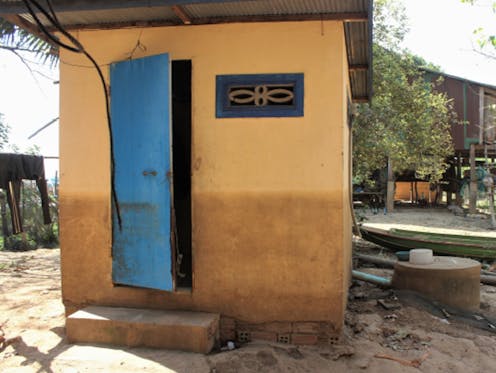
Everyone knows that climate change has consequences, such as a higher likelihood of severe floods, hurricanes and droughts. But here’s a lesser-known problem: Climate change makes toilets more likely to break, which leaves people more likely to “go” outside.
That’s what colleagues and I found when we studied households across six rural Cambodian provinces, focusing on their access to proper toilets and when people decide to abandon sanitary systems in favor of open defecation, or “going” outside.
We analyzed sanitation behavior surveys that were given to about 200,000 households every two years from 2013 to 2020. These questionnaires looked into how households maintained access to sanitary toilet systems, when these facilities were abandoned, and why. It also inquired about the poverty status of the households.
A second survey of 1,472 households that owned a pour-flush latrine purchased through local sanitation businesses supported by the nonprofit organization iDE looked at how well these toilets functioned, as well as attitudes toward waste management. In this case, waste management refers to how often and when latrine pits are emptied and whether the waste is contained in a safe and hygienic way.
Our goal was to establish how living in regions vulnerable to the effects of climate change affects how well sanitary toilets function, and the impact that has on households’ sanitation practices and perceptions.
The key result of our study, which was published in the peer-reviewed journal Environment, Development and Sustainability, was clear: In regions where climate change makes heavy storms and floods more common, households more frequently stop using and maintaining their toilets.
Toilet dysfunction, which temporarily prevents a toilet from flushing or from keeping human waste from entering the environment, is more frequent among households living in flood-prone regions during the rainy season. We found that for every point increase in the composite climate vulnerability index, toilet abandonment went up by 4%.
Unsurprisingly, we found that the poorest households were hit hardest. For every percentage point increase in the number of households living in poverty for any one district, toilet abandonment went up by 1.2%.
Why it matters
Going to the toilet is a basic human necessity, yet more than half the world’s population uses toilets that do not treat human waste before it reenters the environment, typically into rivers.
Moreover, a 2021 report by the World Health Organization and UNICEF found that about 673 million people have no toilets at all and are forced to defecate out in the open.
This is a huge source of pollution and a major risk to human health. Poor sanitation also drastically increases the burden on water treatment systems.
Nonprofits such as iDE, which I consult with and was a partner on this study, are working to improve toilet access and safe practices. In Cambodia, iDE has facilitated the sale of more than 411,000 pour-flush latrines across nine provinces since 2009, contributing to five of these provinces being declared “open defecation free,” meaning that people no longer go to the bathroom outside. Because people pay for their own toilets, they tend to maintain and use them, promoting long-term sustainability to sanitation access.
But this improvement is at risk of being reversed through the increased frequency of climate change-related weather events. In lower-income countries such as Cambodia, seasonal flooding, which is becoming more severe, threatens to disable and damage sanitation infrastructure.
Without improvements to strategies, products and services that mitigate and adapt to climate shocks, people are likely to unsafely dispose of their human waste or be forced to return to open defecation. This is a major contamination risk to water sources and the environment, increasing the risk of sickness.
What isn’t known
We are keen to form more partnerships to continue to study what difference other factors make when it comes to encouraging safe and sanitary toilet practices. This includes looking at the impact of the gender of household purchasers and users, and the proximity of communities to cities and transport links, as well as wastewater treatment options, the density of populations and political will to improve the sanitation of rural communities.
The Research Brief is a short take on interesting academic work.
James Harper studies sanitation and other basic human needs in partnership with non-profit organizations, like iDE on this study, around the world through his business, Realize Research, LLC.
This article was originally published on The Conversation. Read the original article.







